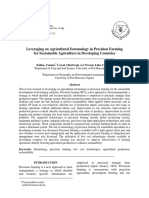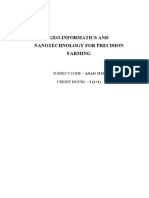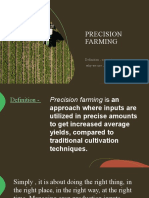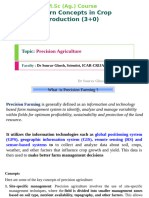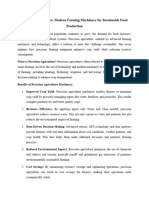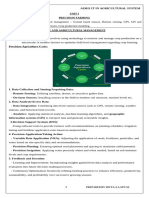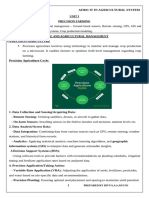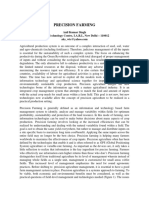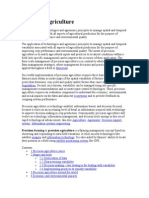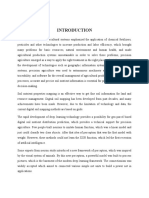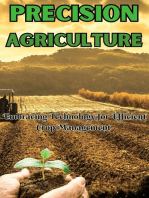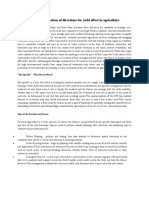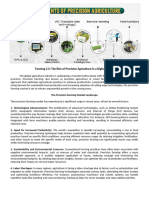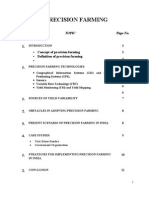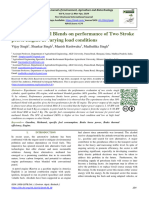Precision Farming: A Review of Methods, Technologies, and Future Prospects
Precision Farming: A Review of Methods, Technologies, and Future Prospects
Uploaded by
Mamta AgarwalCopyright:
Available Formats
Precision Farming: A Review of Methods, Technologies, and Future Prospects
Precision Farming: A Review of Methods, Technologies, and Future Prospects
Uploaded by
Mamta AgarwalCopyright
Available Formats
Share this document
Did you find this document useful?
Is this content inappropriate?
Copyright:
Available Formats
Precision Farming: A Review of Methods, Technologies, and Future Prospects
Precision Farming: A Review of Methods, Technologies, and Future Prospects
Uploaded by
Mamta AgarwalCopyright:
Available Formats
International Journal of Environment, Agriculture and Biotechnology
Vol-9, Issue-2; Mar-Apr, 2024
Peer-Reviewed International Journal
Journal Home Page Available: https://ijeab.com/ Journal DOI: 10.22161/ijeab
NAAS Score: 4.74
Precision Farming: A Review of Methods, Technologies,
and Future Prospects
Manish Kushwaha1, Shankar Singh2, Vijay Singh3, Shashank Dwivedi4
1,3
Assistant Professor, Department Agricultural Engineering, AKS University, SATNA (Madhya Pradesh).
2 AgriculturalEngineering Specialist, SKRAU, BIKANER, (Rajasthan).
4 Administrative Officer, Agricultural Insurance Company of India Limited, Ahmadabad, (Gujrat).
Author communication mail id- Manishkushwaha2@gmail.com
Received: 02 Mar 2024; Received in revised form: 12 Apr 2024; Accepted: 21 Apr 2024; Available online: 30 Apr 2024
©2024 The Author(s). Published by Infogain Publication. This is an open access article under the CC BY license
(https://creativecommons.org/licenses/by/4.0/).
Abstract— Precision farming, often referred to as precision agriculture, is a farming management concept
that seeks to maximize agricultural operations via the use of technology in order to achieve greater levels
of efficiency, production, and conservation of resources. The purpose of this survey study is to offer an
overview of precision farming, including topics such as its fundamentals, methodologies, technology, and
applications. It investigates the role that a variety of technologies, including global navigation satellite
systems (GNSS), geographic information systems (GIS), remote sensing, and sensor technology, play in
making it possible to implement precision agricultural methods. In addition, it addresses the advantages,
disadvantages, and potential future applications of precision farming in the context of solving issues
related to the sustainability of agriculture and the security of food supplies on a worldwide scale.
Keywords—- GNSS, GIS, Remote sensing.
I. INTRODUCTION positioning systems (GPS), geographic information
The notion of precision farming, which is often referred to systems (GIS), and remote sensing, farmers are able to
as precision agriculture, is a farming management concept properly map and analyze these changes, which enables
that makes use of cutting-edge technology and data-driven them to make educated choices on the distribution of
methodologies in order to improve agricultural operations resources such as seeds, water, pesticides, and fertilizers.
on a geographical and temporal scale. Instead of applying By ensuring that crops get the appropriate quantity of
agricultural inputs and techniques in a consistent manner nutrients and water exactly when and where they are
over wide regions, the fundamental goal of precision required, this focused application of inputs maximizes the
farming is to adjust them to the precise requirements of potential for growth and yield as well as the potential for
individual plants or tiny zones within a field. Through the growth.
use of this strategy, farmers are able to optimize their The concept of precision farming is founded on the
production, reduce their input consumption, and mitigate principle of site-specific management, which recognizes
their environmental consequences, which eventually that soil characteristics, topography, climate, and other
results in agricultural systems that are more efficient and factors vary within a field. By accurately mapping and
sustainable. analyzing these variations using technologies such as GPS,
Precision farming is based on the premise of site-specific GIS, and remote sensing, farmers can make informed
management, which acknowledges that the properties of decisions about the allocation of resources such as
the soil, terrain, climate, and other elements change within fertilizers, pesticides, water, and seeds. This targeted
a field. This provides the foundation for the concept of application of inputs ensures that crops receive the right
precision farming. Using technology like as global amount of nutrients and water precisely when and where
they are needed, optimizing growth and yield potential.
ISSN: 2456-1878 (Int. J. Environ. Agric. Biotech.)
https://dx.doi.org/10.22161/ijeab.92.27 242
Kushwaha et al. Precision Farming: A Review of Methods, Technologies, and Future Prospects
Key components of precision farming include: within agricultural systems. Precision farming is a
1) Data Collection: Precision farming relies on the comprehensive approach that utilizes various
collection of accurate and timely data about soil technologies and scientific knowledge to optimize
properties, crop health, weather conditions, and other agricultural production by considering variability and
relevant factors. This data can be obtained through uncertainties within agricultural systems. These
various means, including satellite imagery, drones, technologies and knowledge are applied to adapt
ground-based sensors, and manual sampling. production inputs site-specifically within a field and
2) Data Analysis: Once collected, data is analyzed to individually for each animal, allowing for better use of
identify patterns, trends, and spatial variability within resources while maintaining.
the field. Advanced analytics techniques, such as Evolution and significance in modern agriculture-
spatial interpolation, statistical modeling, and machine Precision farming in contemporary agriculture represents a
learning, are often employed to derive actionable significant change from conventional agricultural
insights from the data. techniques to data-driven and technology-enabled
3) Decision Support Systems: Based on the analysis of approaches, with profound implications for the industry. In
data, decision support systems provide farmers with the past, agriculture mostly used broad methods, applying
recommendations and guidance for optimizing farm fertilizers, insecticides, and water equally over extensive
management practices. These systems may include areas, without considering differences in soil qualities,
software tools, mobile applications, and online terrain, or crop needs. Nevertheless, the introduction of
platforms that integrate data from multiple sources precision farming has completely transformed this way of
and provide real-time monitoring and decision-making thinking by using sophisticated technology to customize
support. agricultural methods according to the unique requirements
4) Precision Application Technologies: Precision of each field or even tiny areas within fields.
farming relies on technologies that enable the precise Precision farming originated in the late 20th century, with
application of inputs, such as variable rate application the early use of technology like Global Positioning
equipment, GPS-guided machinery, and automated Systems (GPS) and Geographic Information Systems
irrigation systems. These technologies allow farmers (GIS) in agriculture. These technologies allowed farmers
to adjust input rates and application timing based on to precisely delineate field borders, evaluate soil
site-specific conditions, maximizing efficiency and properties, and evaluate the condition of crops from a
minimizing waste. Precision farming is a spatial standpoint. With the advancement and affordability
comprehensive concept that incorporates various of processing power, precision farming solutions have
technologies and scientific knowledge, such as broadened to include remote sensing technologies like
computer science, electronics, and geoprocessing. satellite images and drones, along with sensor-based
These technologies and knowledge are applied in monitoring systems for collecting real-time data.
agriculture to optimize production by accounting for
Precision farming is very important in contemporary
variability and uncertainties within agricultural
agriculture because to its capacity to optimize resource
systems. Precision farming involves the use of
utilization, improve crop productivity, and limit negative
sensors, information systems, enhanced machinery,
effects on the environment. Farmers may enhance
and informed management to adapt production inputs
efficiency and output while minimizing waste by
site-specifically within a field and individually
accurately directing inputs such as fertilizers, herbicides,
foreach animal.
and water to specific regions of the field where they are
5) This approach allows for better resource utilization,
most required. This focused strategy not only enhances
reduces the need for fertilizers, and improves water
economic benefits for farmers but also reduces
efficiency. By utilizing technology such as satellite
environmental hazards linked to excessive pesticide use
positioning, internet-of-things, and data analytics,
and fertilizer runoff.
precision farming enables farmers to monitor and
manage the quantity and quality of agricultural Furthermore, precision farming enables farmers to make
produce, while also maintaining the quality of the decisions based on data, enabling them to closely monitor
environment and improving the sustainability of the the development of crops, identify pests and illnesses at an
food supply. Precision farming is a comprehensive early stage, and take proactive measures to adapt to
approach that utilizes various technologies and changing circumstances. Precision farming utilizes the
scientific knowledge to optimize agricultural integration of diverse data sources and sophisticated
production by considering variability and uncertainties analytics to help farmers optimize planting schedules,
ISSN: 2456-1878 (Int. J. Environ. Agric. Biotech.)
https://dx.doi.org/10.22161/ijeab.92.27 243
Kushwaha et al. Precision Farming: A Review of Methods, Technologies, and Future Prospects
improve irrigation management, and anticipate crop yields informed decisions about crop management
with enhanced accuracy. This improved decision practices.
assistance enables farmers to reduce risks and maximize Continuous Monitoring and Adjustment:
profits in a climate that is becoming more uncertain and
varied. • Precision farming involves ongoing monitoring of
crop conditions, soil moisture levels, nutrient status, and
Precision farming not only provides advantages at the farm other relevant parameters throughout the growing season.
level, but also plays a vital role in tackling wider issues Monitoring may be conducted using remote sensing
that contemporary agriculture faces, including food technologies, sensor networks, and on-the-ground
security, sustainability, and climate change adaptation. observations. Based on real-time data and feedback,
Precision farming enhances resource efficiency and farmers can make timely adjustments to management
resilience, hence promoting the sustainable sustainability practices, such as adjusting irrigation schedules, applying
of agricultural systems and safeguarding food security for additional inputs to areas of deficiency, or implementing
an expanding global population. Precision farming pest control measures. Continuous monitoring and
promotes the shift towards sustainable and eco-friendly adjustment enable farmers to respond quickly to changing
agricultural techniques by decreasing greenhouse gas conditions and optimize crop performance throughout the
emissions, limiting soil erosion, and protecting water growing season.
quality.
Principles of Precision Farming: The principles of II. TECHNOLOGIES ENABLING PRECISION
precision farming are centered on the fundamental ideas of FARMING
site-specific management, data-driven decision-making,
and ongoing monitoring and modification. The Global Navigation Satellite Systems (GNSS): Global
deployment of precision farming methods and technology Navigation Satellite Systems (GNSS) play a crucial role in
is guided by these principles, which allow farmers to enabling precision farming by providing accurate
maximize agricultural productivity while reducing inputs positioning and navigation information to agricultural
and environmental consequences. The following are the machinery and devices. GNSS technologies, such as GPS
fundamental tenets of precision agriculture: (Global Positioning System), GLONASS (Global
Navigation Satellite System), and more recently Galileo
Site-Specific Management: and BeiDou, offer farmers precise location data, which is
• Site-specific management recognizes that essential for implementing site-specific management
agricultural fields exhibit spatial variability in soil practices and precision agriculture techniques. Here's how
properties, topography, and other factors that GNSS technologies facilitate precision farming:
influence crop growth and productivity. Accurate Positioning: GNSS receivers installed on
• Instead of treating the entire field as uniform, agricultural equipment and devices receive signals from
precision farming identifies and manages small zones satellites orbiting the Earth, allowing them to determine
or management units within the field based on their their precise position in real-time. This accurate
unique characteristics. positioning is essential for guiding farm machinery during
• By tailoring management practices, such as planting, field operations, such as planting, spraying, harvesting,
fertilization, and irrigation, to the specific needs of and soil sampling, ensuring that operations are carried out
each zone, farmers can optimize resource use and with high precision and efficiency.
maximize yield potential.
Guidance Systems: GNSS-based guidance systems
• Data-Driven Decision-Making: Precision farming
provide farmers with visual or audible cues to follow
relies on accurate and timely data to inform decision-
predefined paths or patterns in the field, such as straight-
making processes. This data may include information
line rows or curved contours. By guiding agricultural
on soil properties, crop health, weather conditions,
machinery along precise paths, guidance systems help
and historical yield data.
reduce overlaps and skips in input application, minimizing
• Advanced technologies, such as GPS, GIS, remote
input wastage and optimizing resource use.
sensing, and sensor networks, are used to collect,
analyze, and interpret data from the field. Auto-Steering: Auto-steering systems use GNSS data to
• By integrating data from multiple sources and automatically steer agricultural vehicles, such as tractors
applying advanced analytics techniques, farmers can and sprayers, along predefined routes with high accuracy.
gain insights into spatial variability and make These systems eliminate the need for manual steering by
ISSN: 2456-1878 (Int. J. Environ. Agric. Biotech.)
https://dx.doi.org/10.22161/ijeab.92.27 244
Kushwaha et al. Precision Farming: A Review of Methods, Technologies, and Future Prospects
the operator, reducing fatigue and allowing for more 3. Galileo: Galileo is the European Union's global
consistent and precise field operations. satellite navigation system, designed to provide
Mapping and Georeferencing: GNSS technology enable independent, reliable positioning and timing services
the creation of accurate field maps and georeferenced data to users worldwide. Galileo aims to offer higher
layers, which are essential for site-specific management positioning accuracy, integrity, and availability
and decision-making. Field boundaries, soil sampling compared to existing GNSS systems like GPS and
points, crop health assessments, and yield maps can be GLONASS. In precision farming, Galileo satellites
precisely georeferenced using GNSS data, facilitating can augment GPS and GLONASS signals, enhancing
spatial analysis and management. the overall accuracy and robustness of positioning
information for agricultural applications.
Integration with Precision Farming Technologies:
GNSS receivers are integrated with other precision 4. BeiDou: BeiDou is China's satellite navigation
farming technologies, such as variable rate application system, which provides regional and global
(VRA) systems and data management software. By positioning services similar to GPS and GLONASS.
combining GNSS positioning data with information on soil BeiDou offers improved accuracy, coverage, and
properties, crop performance, and input requirements, signal availability in the Asia-Pacific region, where it
farmers can implement targeted input application strategies is being increasingly used for precision farming and
tailored to the specific needs of different areas within a other applications. In precision farming, BeiDou
field. receivers can provide additional satellite signals to
complement GPS, GLONASS, and Galileo, further
Role of GPS, GLONASS, and other satellite Systems; -
enhancing positioning accuracy and reliability in
Global Navigation Satellite Systems (GNSS), including
diverse environments.
GPS (Global Positioning System), GLONASS (Global
Navigation Satellite System), and other satellite systems Precision agriculture applications of GNSS technology-
like Galileo and BeiDou, play a critical role in precision Global Navigation Satellite Systems (GNSS) technology,
farming by providing accurate positioning, navigation, and such as GPS (Global Positioning System), GLONASS
timing information to agricultural applications. Here's how (Global Navigation Satellite System), Galileo, and
each of these satellite systems contributes to precision BeiDou, offers a wide range of applications in precision
farming: agriculture. These applications leverage GNSS capabilities
to enhance efficiency, accuracy, and productivity in
1. GPS (Global Positioning System): GPS is a satellite-
various farming operations. Here are some precision
based navigation system developed and operated by
agriculture applications of GNSS technology:
the United States government. GPS provides global
coverage and accurate positioning information to 1. Field Mapping and Boundary Definition: GNSS
users equipped with GPS receivers. In precision technology enables farmers to accurately map field
farming, GPS technology enables farmers to precisely boundaries and delineate management zones within
determine the location of agricultural machinery, fields. GPS receivers integrated with mapping
equipment, and sensors in the field. GPS receivers are software allow farmers to create detailed field maps,
integrated into various precision farming applications, which serve as a basis for precision agriculture
such as auto-steering systems, guidance systems, and practices such as variable rate application (VRA) and
yield monitors, allowing farmers to conduct field site-specific management.
operations with high accuracy and efficiency. 2. Auto-Steering and Guidance Systems: Auto-
2. GLONASS (Global Navigation Satellite System): steering systems use GNSS signals to automatically
GLONASS is a satellite-based navigation system steer agricultural vehicles, such as tractors, combines,
developed by Russia, which provides similar and sprayers, along predefined paths or guidance
positioning and navigation capabilities to GPS. lines. By maintaining accurate positioning and
GLONASS complements GPS by offering additional guidance, auto-steering systems reduce operator
satellite coverage and redundancy, particularly at high fatigue, minimize overlaps and skips in field
latitudes and in urban environments where GPS operations, and ensure precise implement placement.
signals may be obstructed or degraded. In precision 3. Variable Rate Application (VRA): GNSS
farming, GLONASS receivers can be used alongside technology enables variable rate application (VRA) of
GPS receivers to improve positioning accuracy and inputs such as fertilizers, pesticides, and irrigation
reliability, especially in challenging environments. water based on spatial variability within fields. By
integrating GPS data with soil maps, yield maps, and
ISSN: 2456-1878 (Int. J. Environ. Agric. Biotech.)
https://dx.doi.org/10.22161/ijeab.92.27 245
Kushwaha et al. Precision Farming: A Review of Methods, Technologies, and Future Prospects
other spatial information, farmers can apply inputs at factors such as soil type, topography, and historical
varying rates according to the specific needs of yield data.
different areas within a field, optimizing resource use 2. Soil Mapping and Analysis: GIS enables farmers to
and crop yields. create soil maps that depict spatial variability in soil
4. Yield Monitoring and Mapping: GNSS-equipped properties, such as texture, pH, organic matter content,
yield monitors installed on harvesters collect real-time and nutrient levels. By overlaying soil maps with other
data on crop yields as they are harvested. GPS data layers, such as yield maps and crop health
positioning data is integrated with yield data to create imagery, farmers can identify areas of nutrient
detailed yield maps, which provide insights into deficiency or soil compaction and implement targeted
spatial variability in crop performance and guide management practices, such as variable rate
future management decisions. fertilization or soil remediation.
5. Soil Sampling and Precision Soil Management: 3. Yield Monitoring and Analysis: GIS is used to analyze
GNSS technology facilitates precise soil sampling by and visualize yield data collected from precision
accurately recording sample locations in the field. agriculture equipment, such as yield monitors on
GPS-guided soil sampling allows farmers to collect harvesters. By creating yield maps that display spatial
soil samples at predetermined locations, ensuring variability in crop yields across the field, farmers can
representative sampling and enabling site-specific soil identify patterns, trends, and areas of
nutrient management strategies. underperformance or overperformance, informing
6. Irrigation Management: GNSS technology supports future management decisions and crop planning.
precision irrigation by providing accurate positioning 4. Precision Application of Inputs: GIS-based prescription
for irrigation equipment and sensors. GPS-guided mapping allows farmers to create application maps for
irrigation systems can adjust water application rates variable rate application (VRA) of inputs, such as
based on spatial variability in soil moisture levels and fertilizers, pesticides, and irrigation water. By
crop water requirements, optimizing water use integrating GIS data with agronomic models and soil
efficiency and minimizing water waste. test results, farmers can generate prescription maps that
7. Remote Sensing Integration: GNSS data can be specify optimal input rates for different areas within the
integrated with remote sensing technologies, such as field, optimizing resource use and maximizing crop
satellite imagery and drones, to monitor crop health yields.
and growth patterns. By combining GNSS positioning 5. Remote Sensing Integration: GIS facilitates the
with remote sensing data, farmers can identify areas of integration of remote sensing data, such as satellite
stress, disease, or nutrient deficiency in crops and imagery and aerial photographs, into precision farming
target management interventions accordingly. workflows. By overlaying remote sensing data with
GIS layers, farmers can monitor crop health, detect
pests and diseases, assess vegetation vigor, and track
Geographic Information Systems (GIS):- Geographic
changes in land cover and land use over time.
Information Systems (GIS) are powerful tools that play a
crucial role in precision farming by enabling farmers to 6. Decision Support Systems: GIS-based decision support
manage, analyze, and visualize spatial data related to systems provide farmers with tools for spatial analysis,
agricultural operations. GIS technology integrates scenario modeling, and risk assessment. By combining
geographic data, such as maps, satellite imagery, and field GIS capabilities with advanced analytics techniques,
observations, with attribute data, such as soil such as spatial interpolation, suitability analysis, and
characteristics, crop types, and yield data, to provide multi-criteria decision-making, farmers can make
valuable insights for decision-making. Here's how GIS is informed decisions about crop management practices,
utilized in precision farming: land use planning, and resource allocation.
1. Field Mapping and Management: GIS allows farmers
to create detailed maps of their fields, including Remote Sensing: Remote sensing, using satellite and
boundaries, management zones, and infrastructure such aerial imaging, is essential in precision farming since it
as irrigation systems and drainage ditches By digitizing provides vital data for monitoring crops, estimating yields,
field boundaries and other features, farmers can detecting diseases, and analyzing soil. Remote sensing is
accurately delineate management zones based on used in precision farming to get accurate results.
ISSN: 2456-1878 (Int. J. Environ. Agric. Biotech.)
https://dx.doi.org/10.22161/ijeab.92.27 246
Kushwaha et al. Precision Farming: A Review of Methods, Technologies, and Future Prospects
Crop monitoring: - It is the use of satellite and aerial to collect real-time data on soil, weather, crop, and
imaging to observe and assess the progress, advancement, environmental conditions. These sensors are
and condition of crops over the whole period of growth. strategically placed throughout the field to capture
Satellites and drones acquire high-resolution images that spatial variability in parameters such as soil moisture,
offers farmers precise information on crop conditions, such temperature, nutrient levels, and crop health. Sensors
as the extent of canopy cover, the amount of biomass may be installed in the soil, on weather stations, on
accumulated, and the various phases of plant development. drones, or mounted on agricultural machinery to
Through the examination of changes in the patterns of continuously monitor field conditions during the
light reflected by crops over a period of time, farmers are growing season.
able to evaluate the overall condition of the crops, identify 2. Monitoring Soil Moisture: Soil moisture sensors are
elements that may be causing stress (such as lack of used to measure the moisture content of the soil at
nutrients, insufficient water, or infestations of pests), and different depths and locations within the field. These
pinpoint regions where there is a risk of reduced crop sensors provide real-time information on soil moisture
output. Crop yields are estimated using remote sensing levels, allowing farmers to assess soil water availability
data, which involves assessing crop biomass, vegetation and make informed decisions about irrigation
indices, and other indications of agricultural production. scheduling. By monitoring soil moisture continuously,
Farmers may use remote sensing data, in conjunction with farmers can optimize irrigation timing and volume,
ground-based measurements and historical yield data, to reduce water use, and minimize the risk of
calibrate and establish models that can accurately forecast overwatering or underwatering crops.
crop yields at various development stages and across
3. Monitoring Soil Temperature:
diverse fields. Remote sensing-based yield prediction
enables farmers to evaluate crop performance, make Soil temperature sensors measure the temperature of the
prompt choices about harvest timing, and strategize for soil at various depths to assess soil thermal properties
grain storage and sale. and conditions. These sensors help farmers monitor soil
temperature fluctuations throughout the day and across
Disease Detection: Crop diseases and pest infestations are
different seasons, which is critical for crop growth and
detected and monitored using satellite and aerial images.
development. By tracking soil temperature, farmers can
Remote sensing data may be used to detect spatial patterns
optimize planting schedules, manage crop emergence
of disease outbreaks, enabling farmers to identify regions
and growth stages, and mitigate the risk of frost
with high disease prevalence and prioritize management
damage or heat stress.
actions. By combining remote sensing data with disease
models and on-site observations, farmers may use specific 4. Monitoring Nutrient Levels: -Nutrient sensors are used
control measures, such as pesticide usage or crop rotation, to monitor soil nutrient levels, such as nitrogen (N),
to reduce disease transmission and limit decreases in phosphorus (P), potassium (K), and other essential
agricultural output. nutrients. These sensors provide real-time data on soil
nutrient concentrations, allowing farmers to assess
Soil analysis: - It is involves the use of remote sensing
nutrient availability and make informed decisions about
methods, such as hyperspectral imaging and soil moisture
fertilizer applications. By monitoring nutrient levels
mapping, to evaluate soil qualities and conditions. Satellite
continuously, farmers can implement precision nutrient
and aerial images may be used to accurately monitor soil
management strategies, adjust fertilizer rates, and
moisture levels, soil texture, organic matter content, and
reduce nutrient losses through leaching or runoff.
soil salinity over extensive agricultural regions. Through
the examination of regional heterogeneity in soil 5. Monitoring Other Environmental Parameters: Sensor
parameters, farmers may enhance irrigation scheduling, technology is also used to monitor other environmental
customize nutrient management tactics, and pinpoint parameters, such as air temperature, humidity, wind
regions susceptible to soil deterioration or erosion. speed, solar radiation, and atmospheric pressure. These
sensors provide valuable data for assessing
Sensor Technology: Sensor technology plays a vital role
microclimate conditions, predicting weather patterns,
in precision farming by enabling real-time data collection
and optimizing agronomic practices such as pest
and monitoring of various environmental and crop-related
management, crop spraying, and harvesting operations.
parameters. Here's how sensor technology contributes to
precision farming:
1. Deployment of Sensors for Real-Time Data Collection: Precision Farming Applications: Precision farming
Sensor networks are deployed across agricultural fields encompasses a variety of applications aimed at optimizing
ISSN: 2456-1878 (Int. J. Environ. Agric. Biotech.)
https://dx.doi.org/10.22161/ijeab.92.27 247
Kushwaha et al. Precision Farming: A Review of Methods, Technologies, and Future Prospects
agricultural practices, improving efficiency, and enhancing optimizing soil fertility, and mitigating yield-limiting
sustainability. Here are some key precision farming factors within the field.
applications: 3. Cost Savings: VRT helps farmers reduce input costs
1. Variable Rate Technology (VRT): Variable Rate by avoiding over-application of inputs in areas with
Technology (VRT) is a precision farming practice that sufficient nutrient levels and minimizing input
involves the adaptive application of agricultural inputs, expenditures in low-yield or unproductive areas. By
such as fertilizers, pesticides, and irrigation water, optimizing input use efficiency, farmers can achieve
based on spatial variability within fields. Instead of cost savings while maintaining or improving crop
applying inputs uniformly across the entire field, VRT yields and profitability.
allows farmers to tailor input application rates to match 4. Environmental Benefits: VRT promotes
the specific needs of different areas or zones within the environmental sustainability by minimizing nutrient
field. Here's how VRT works and its benefits: runoff, reducing soil erosion, and mitigating the risk
Spatial Variability Assessment: VRT begins with the of groundwater contamination associated with
assessment of spatial variability within the field, which excessive fertilizer and pesticide use. By targeting
may include variations in soil properties, topography, crop inputs to areas of need, VRT helps minimize
health, and yield potential. Farmers use tools such as soil environmental impacts and improve overall
maps, yield maps, satellite imagery, and soil sensors to sustainability of agricultural practices. Variable rate
identify spatial patterns and zones of high and low technology involves the application of inputs, such as
productivity within the field. fertilizers, pesticides, and irrigation water, at variable
Prescription Map Generation: Based on the spatial rates based on spatial variability within fields. By
variability assessment, farmers generate prescription maps integrating data from soil maps, yield maps, and other
that specify optimal input rates for different zones or sources, farmers can create prescription maps that
management units within the field. specify optimal input rates for different areas of the
field. VRT allows farmers to tailor input applications
Prescription maps are created using specialized software
to match the specific needs of crops, optimize
that integrates data from various sources, such as GIS,
resource use, and maximize yield potential while
GPS, remote sensing, and soil sampling, to generate
minimizing environmental impacts.
recommendations for input application rates.
5. Precision Irrigation: Precision irrigation involves the
1. Adaptive Input Application: Using VRT-enabled
precise application of water to crops based on real-
equipment, such as variable rate fertilizer spreaders,
time monitoring of soil moisture levels and crop water
sprayers, or irrigation systems, farmers apply inputs at
requirements. Sensor technology and automated
variable rates according to the prescription maps.
irrigation systems enable farmers to apply water only
VRT equipment is equipped with GPS guidance
when and where it is needed, reducing water waste
systems and controllers that adjust input application
and improving water use efficiency. Precision
rates in real-time as the equipment moves through the
irrigation helps optimize crop growth, minimize water
field. Input rates may vary based on factors such as
stress, and mitigate the risk of over-irrigation, soil
soil fertility, crop nutrient requirements, historical
erosion, and nutrient leaching.
yield data, and environmental conditions.
6. Crop Monitoring and Management: Crop monitoring
and management applications utilize remote sensing,
Benefits of Variable Rate Technology (VRT): satellite imagery, and sensor technology to monitor
1. Optimized Resource Use: VRT allows farmers to crop health, growth, and development. Farmers can
apply inputs more precisely, matching input rates to use aerial imagery, drones, and satellite data to assess
the specific needs of different areas within the field. crop conditions, detect pest infestations, diseases, and
By applying inputs where they are most needed and nutrient deficiencies, and identify areas of potential
reducing inputs in areas with lower requirements, yield variability within fields. By monitoring crops
farmers can optimize resource use efficiency and continuously and responding to changes in real-time,
minimize input wastage. farmers can implement timely management
interventions, such as pest control measures, nutrient
2. Increased Yield Potential: Tailoring input application
applications, and irrigation adjustments, to optimize
rates to match crop requirements can help maximize
crop performance and minimize yield losses.
yield potential by addressing nutrient deficiencies,
ISSN: 2456-1878 (Int. J. Environ. Agric. Biotech.)
https://dx.doi.org/10.22161/ijeab.92.27 248
Kushwaha et al. Precision Farming: A Review of Methods, Technologies, and Future Prospects
7. Data Analytics and Decision Support Systems: Data amount of water at the right time, optimizing water
analytics and decision support systems integrate data use efficiency and crop productivity.
from multiple sources, such as GPS, GIS, remote 3. Reduction of Water Waste: Precision irrigation
sensing, and sensor networks, to provide farmers with minimizes water waste by avoiding over-irrigation
insights and recommendations for informed decision- and runoff, which can occur with conventional
making. These systems analyze historical data, predict irrigation methods. By applying water directly to the
future trends, and generate actionable root zone and avoiding surface runoff, precision
recommendations for optimizing agronomic practices, irrigation systems reduce water losses due to
input applications, and resource allocation. By evaporation, deep percolation, and surface runoff. Soil
leveraging advanced analytics techniques, such as moisture sensors prevent irrigation when soil moisture
machine learning and artificial intelligence, farmers levels are adequate, avoiding unnecessary water
can improve yield prediction accuracy, optimize application and conserving water resources.
resource use efficiency, and enhance overall farm
4. Environmental Impact Reduction: Precision irrigation
management.
helps reduce the environmental impact of agriculture
8. Precision Livestock Farming: Precision farming by minimizing water use, nutrient leaching, and soil
techniques are also applied to livestock management, erosion. By conserving water resources and reducing
including animal health monitoring, feed nutrient runoff, precision irrigation systems protect
management, and environmental monitoring. Sensor water quality and aquatic ecosystems. Reduced energy
technology, GPS tracking, and data analytics enable consumption associated with pumping and distributing
farmers to monitor animal behavior, health status, and water also contributes to lower greenhouse gas
performance metrics in real-time. Precision livestock emissions and environmental sustainability.
farming helps optimize feed efficiency, reduce disease
risks, improve animal welfare, and enhance overall
productivity and profitability in animal agriculture. III. BENEFITS OF PRECISION IRRIGATION
Precision Irrigation: Precision irrigation is a key 1. Improved Water Use Efficiency: Precision irrigation
component of precision farming that focuses on efficient optimizes water use efficiency by delivering water
water management through the use of sensor-based directly to the root zone of crops, minimizing losses
irrigation systems. These systems leverage technology to due to evaporation, runoff, and deep percolation. By
optimize water application, minimize water waste, and matching water application rates to crop water
reduce the environmental impact of irrigation practices. requirements, precision irrigation systems ensure that
Here's how precision irrigation works and its benefits: water is used more efficiently, maximizing crop yields
per unit of water applied.
1. Sensor-Based Irrigation Systems: Precision irrigation
systems utilize sensors to monitor soil moisture levels, 2. Enhanced Crop Performance: By providing crops with
weather conditions, crop water requirements, and optimal moisture levels, precision irrigation systems
other relevant parameters in real-time. Soil moisture promote healthy root development, balanced growth,
sensors are installed at various depths within the root and improved crop vigor. Consistent soil moisture
zone to continuously monitor soil moisture content. levels help reduce water stress, increase nutrient
Weather stations or sensors measure environmental uptake, and enhance crop resilience to environmental
factors such as temperature, humidity, wind speed, stresses such as drought and heat.
and solar radiation. 3. Cost Savings: Precision irrigation systems help farmers
2. Adaptive Water Application: Based on data collected reduce water, energy, and labor costs associated with
by sensors, precision irrigation systems adjust water irrigation. By optimizing water use efficiency and
application rates and timing to match crop water minimizing input wastage, precision irrigation systems
requirements and soil moisture levels. Automated can lead to significant cost savings over time,
controllers and actuators regulate irrigation improving the profitability of agricultural operations.
equipment, such as drip irrigation systems, sprinklers, 4. Environmental Sustainability: Precision irrigation
or center pivots, to deliver precise amounts of water contributes to environmental sustainability by
only when and where it is needed. By dynamically conserving water resources, minimizing water
responding to changing conditions, precision pollution, and reducing greenhouse gas emissions. By
irrigation systems ensure that crops receive the right adopting precision irrigation practices, farmers can
minimize their environmental footprint and contribute
ISSN: 2456-1878 (Int. J. Environ. Agric. Biotech.)
https://dx.doi.org/10.22161/ijeab.92.27 249
Kushwaha et al. Precision Farming: A Review of Methods, Technologies, and Future Prospects
to the long-term sustainability of agricultural extreme weather events through efficient water
production systems. management practices.
Precision irrigation involves the use of sensor-based Crop Monitoring and Management: Crop monitoring
irrigation systems to achieve efficient water management, and management are crucial components of precision
minimize water waste, and reduce the environmental farming, and remote sensing plays a significant role in
impact of irrigation practices. Here's how precision assessing crop health and detecting pests, diseases, and
irrigation accomplishes these goals: nutrient deficiencies. Here's how remote sensing is utilized
Efficient Water Management: Sensor-based irrigation for crop monitoring and management in precision farming:
systems utilize various sensors to monitor soil moisture 1. Remote Sensing for Crop Health Assessment:
levels, weather conditions, crop water requirements, and Remote sensing technologies, such as satellite imagery,
other relevant parameters in real-time. Soil moisture aerial photography, and drones, are used to assess crop
sensors are installed at different depths within the root health and vigor. These remote sensing platforms capture
zone to continuously monitor soil moisture content. multispectral or hyperspectral images of agricultural fields,
Weather stations or sensors measure environmental factors which can reveal subtle variations in crop reflectance
such as temperature, humidity, wind speed, and solar associated with different health conditions. By analyzing
radiation. Based on data collected by sensors, precision spectral signatures and vegetation indices derived from
irrigation systems dynamically adjust water application remote sensing data, farmers can assess crop health,
rates and timing to match crop water requirements and soil monitor growth dynamics, and identify areas of stress or
moisture levels. Automated controllers and actuators decline within fields. Crop health assessment using remote
regulate irrigation equipment, such as drip irrigation sensing helps farmers make informed decisions about
systems, sprinklers, or center pivots, to deliver precise management interventions, such as irrigation scheduling,
amounts of water only when and where it is needed. By nutrient application, and pest control.
optimizing water application rates and timing, precision 2. Early Detection of Pests, Diseases, and Nutrient
irrigation systems ensure that crops receive the right Deficiencies: Remote sensing enables the early detection
amount of water at the right time, maximizing water use of pests, diseases, and nutrient deficiencies by identifying
efficiency and crop productivity. spatial patterns and anomalies in crop reflectance. Changes
Reduction of Water Waste: Precision irrigation in crop reflectance patterns, such as discoloration,
minimizes water waste by avoiding over-irrigation and chlorosis, or leaf wilting, may indicate the presence of
runoff, which are common with conventional irrigation pests, diseases, or nutrient imbalances. Remote sensing
methods. By applying water directly to the root zone and data can be processed using machine learning algorithms
avoiding surface runoff, precision irrigation systems and image analysis techniques to detect and classify crop
reduce water losses due to evaporation, deep percolation, stress factors based on spectral signatures. By detecting
and surface runoff. Soil moisture sensors prevent irrigation pests, diseases, and nutrient deficiencies early, farmers can
when soil moisture levels are adequate, avoiding implement timely management strategies, such as targeted
unnecessary water application and conserving water pesticide applications, disease control measures, and foliar
resources. Additionally, precision irrigation systems can nutrient sprays, to mitigate yield losses and minimize
incorporate technologies such as drip irrigation, which economic impacts.
delivers water directly to the root zone of plants, further
minimizing water waste.
IV. BENEFITS OF REMOTE SENSING FOR
Environmental Impact Reduction: Precision irrigation CROP MONITORING AND
systems help reduce the environmental impact of MANAGEMENT
agriculture by conserving water resources, minimizing
1. Timely Decision-Making: Remote sensing provides
water pollution, and reducing energy consumption. By
timely and spatially explicit information on crop
optimizing water use efficiency and minimizing nutrient
health and stress factors, allowing farmers to make
runoff, precision irrigation systems protect water quality
proactive management decisions. Early detection of
and aquatic ecosystems. Reduced energy consumption
pests, diseases, and nutrient deficiencies enables
associated with pumping and distributing water also
farmers to intervene before crop damage becomes
contributes to lower greenhouse gas emissions and
severe, maximizing the effectiveness of control
environmental sustainability. Moreover, precision
measures and minimizing yield losses.
irrigation systems can help mitigate the impacts of climate
change by promoting resilience to drought and other
ISSN: 2456-1878 (Int. J. Environ. Agric. Biotech.)
https://dx.doi.org/10.22161/ijeab.92.27 250
Kushwaha et al. Precision Farming: A Review of Methods, Technologies, and Future Prospects
2. Improved Resource Allocation: Remote sensing helps crop yields based on historical data, environmental
optimize resource allocation by targeting management factors, and agronomic variables. Machine learning
interventions to areas of need within fields. By algorithms, statistical models, and crop simulation
identifying spatial variability in crop health and stress, models are employed to predict crop yields at different
farmers can tailor input applications, such as growth stages and across different field zones.
pesticides, fertilizers, and water, to match the specific Predictive modeling considers factors such as soil
requirements of different areas within the field, fertility, weather conditions, crop genetics, and
optimizing resource use efficiency. management practices to generate accurate yield
3. Enhanced Sustainability: Remote sensing supports estimates and forecasts. By predicting crop yields in
sustainable agriculture by promoting integrated pest advance, farmers can anticipate production levels, plan
management (IPM) practices, reducing reliance on harvest schedules, and make informed marketing
chemical inputs, and minimizing environmental decisions to maximize profitability.
impacts. By facilitating precision management 4. Risk Assessment: Data analytics and decision support
practices, such as targeted pesticide applications and systems assess risks associated with agronomic
site-specific nutrient management, remote sensing practices, environmental conditions, and market
contributes to improved environmental sustainability dynamics. Risk assessment models analyze factors such
and reduced pesticide residues in food and water. as weather variability, pest and disease pressure, input
Data Analytics and Decision Support Systems: Data costs, and market volatility to identify potential risks
analytics and decision support systems are essential and vulnerabilities. By quantifying risks and
components of precision farming, enabling farmers to uncertainties, farmers can develop risk management
integrate data from multiple sources and make informed strategies, implement contingency plans, and mitigate
decisions to optimize agricultural practices. These systems the impacts of adverse events on crop production and
leverage advanced analytics techniques, such as predictive profitability.
modeling, to provide insights into crop yield estimation
and risk assessment. Here's how data analytics and V. BENEFITS OF DATA ANALYTICS AND
decision support systems are utilized in precision farming: DECISION SUPPORT SYSTEMS
1. Integration of Data from Multiple Sources: Precision 1. Improved Efficiency: Data analytics and decision
farming involves the collection and integration of data support systems streamline farm management processes,
from various sources, including GPS, GIS, remote optimize resource allocation, and enhance operational
sensing, weather stations, soil sensors, yield monitors, efficiency. By automating data analysis tasks and
and farm management software. Data from these providing actionable insights, these systems enable
sources provide valuable information on soil properties, farmers to make faster, more informed decisions,
weather conditions, crop health, yield variability, and improving productivity and reducing input costs.
management practices. Data analytics platforms and
2. Enhanced Productivity: Data-driven decision-
decision support systems aggregate, process, and
making helps farmers optimize agronomic practices, input
analyze data from multiple sources to generate
applications, and crop management strategies to maximize
actionable insights for farmers.
yield potential and enhance overall productivity. By
2. Informed Decision-Making: Data analytics and leveraging predictive modeling and risk assessment tools,
decision support systems enable farmers to make farmers can identify opportunities for improvement,
informed decisions by providing timely and accurate implement best practices, and achieve higher yields with
information on crop conditions, input requirements, fewer inputs.
and management strategies. These systems analyze
3. Better Risk Management: Data analytics and
historical data, monitor real-time field conditions, and
decision support systems help farmers assess and mitigate
generate recommendations for optimizing agronomic
risks associated with crop production, market fluctuations,
practices, input applications, and resource allocation.
and environmental factors. By identifying potential risks
By integrating data from diverse sources and applying
and vulnerabilities, farmers can develop risk management
advanced analytics techniques, farmers can identify
strategies, diversify operations, and improve resilience to
patterns, trends, and correlations that inform decision-
adverse events, enhancing long-term sustainability and
making and improve farm management practices.
profitability.
3. Predictive Modeling for Crop Yield Estimation:
Predictive modeling techniques are used to estimate
ISSN: 2456-1878 (Int. J. Environ. Agric. Biotech.)
https://dx.doi.org/10.22161/ijeab.92.27 251
Kushwaha et al. Precision Farming: A Review of Methods, Technologies, and Future Prospects
4. Sustainable Agriculture: Data analytics and and technical support services may hinder the
decision support systems support sustainable agriculture adoption of precision farming practices in developing
by promoting precision management practices, optimizing regions. Challenges such as inadequate internet
resource use efficiency, and minimizing environmental connectivity, lack of skilled manpower, and
impacts. By optimizing input applications and reducing insufficient funding for technology investments need
input wastage, farmers can conserve natural resources, to be overcome to promote inclusive adoption of
minimize environmental pollution, and promote ecosystem precision farming.
health and biodiversity.
Precision farming offers a range of benefits that can VI. FUTURE PROSPECTS
revolutionize agricultural practices, but it also faces
The future prospects of precision farming are promising,
significant challenges that need to be addressed for
driven by advancements in technology, data analytics, and
widespread adoption.
the potential to address global food security challenges.
Benefits: Here are some key areas of development and opportunities
1. Increased Productivity and Resource Efficiency: for precision farming:
Precision farming optimizes resource use by applying 1. Advancements in Technology and Data Analytics:
inputs, such as water, fertilizers, and pesticides, Continued advancements in sensor technology, remote
precisely where and when they are needed. By tailoring sensing, and data analytics will enable more precise
management practices to match specific field and efficient monitoring and management of
conditions, precision farming maximizes crop yields agricultural systems. Emerging technologies such as
while minimizing input wastage. Internet of Things (IoT), unmanned aerial vehicles
2. Reduced Environmental Impact: Precision farming (UAVs), and blockchain will further enhance data
practices help mitigate environmental degradation by collection, connectivity, and traceability in precision
minimizing nutrient runoff, soil erosion, and chemical farming. Integration of advanced sensors, robotics, and
leaching. By promoting sustainable agricultural automation will enable autonomous farm operations
practices, precision farming contributes to soil health, and real-time decision-making, improving productivity
water quality, and biodiversity conservation. and sustainability.
3. Enhanced Profitability and Sustainability: Precision 2. Integration of Artificial Intelligence and Machine
farming improves farm profitability by reducing input Learning: Artificial intelligence (AI) and machine
costs, increasing yields, and optimizing operational learning (ML) algorithms offer new opportunities for
efficiency. By adopting precision farming practices, predictive modeling, pattern recognition, and decision
farmers can achieve higher returns on investment while support in precision farming. AI-driven systems can
promoting long-term sustainability and resilience in analyze large datasets, identify trends, and generate
agriculture. actionable insights for optimizing agronomic practices,
Challenges: input applications, and resource allocation. ML
algorithms can learn from historical data, adapt to
1. Initial Investment Costs: The adoption of precision
changing conditions, and optimize management
farming technologies often requires significant upfront
strategies, leading to more efficient and adaptive
investments in equipment, sensors, software, and
precision farming systems.
training. High initial costs may pose barriers to
adoption, particularly for small and medium-sized 3. Potential for Addressing Global Food Security
farmers with limited financial resources. Challenges: Precision farming has the potential to
contribute significantly to global food security by
2. Data Privacy and Security Concerns: Precision
increasing agricultural productivity, improving
farming involves the collection, storage, and analysis
resource use efficiency, and reducing food losses. By
of sensitive data related to farm operations and
optimizing crop yields and minimizing input wastage,
management. Data privacy and security concerns,
precision farming practices can help meet the growing
including unauthorized access, data breaches, and
demand for food in a sustainable and environmentally
misuse of information, need to be addressed to
responsible manner. Precision farming technologies
maintain trust and confidence in precision farming
can also enhance resilience to climate change, mitigate
technologies.
the impacts of extreme weather events, and improve the
3. Accessibility and Adoption Barriers in Developing adaptive capacity of agricultural systems.
Regions: Limited access to technology, infrastructure,
ISSN: 2456-1878 (Int. J. Environ. Agric. Biotech.)
https://dx.doi.org/10.22161/ijeab.92.27 252
Kushwaha et al. Precision Farming: A Review of Methods, Technologies, and Future Prospects
4. Sustainable Intensification and Resilience: Precision and partial least squares regression. Remote Sensing of
farming enables sustainable intensification of Environment, 86(4), 542-553.
agricultural production, allowing farmers to produce [3] Khan, Z., Midega, C. A., Hooper, A. M., and Pickett, J. A.
(2016). Push-pull technology: a conservation agriculture
more food on existing land while minimizing
approach for integrated management of insect pests, weeds
environmental impacts. By adopting precision farming
and soil health in Africa. International Journal of
practices, farmers can enhance the resilience of Agricultural Sustainability, 14(2), 162-170.
agricultural systems to climate variability, water [4] Pandey, P., and Misra, P. (2017). Role of geospatial
scarcity, and other challenges, ensuring food security technology in agriculture: a review. Agriculture Reviews,
for future generations. 38(3), 186-194.
[5] Recha, J. W., Atzberger, C., and Dung, K. J. (2018). Remote
5. Adoption of Digital Agriculture Platforms: Digital
sensing of agriculture in the Hindu Kush Himalaya: a
agriculture platforms, powered by cloud computing,
review. International Journal of Remote Sensing, 39(4),
big data analytics, and mobile technologies, will 1055-1079.
facilitate the adoption and scaling of precision farming [6] Srinivasan, A., Berger, T., Kuehne, C., and Rath, T. (2018).
practices. These platforms provide farmers with access Remote sensing in precision agriculture: a review. Journal
to real-time data, decision support tools, and agronomic of Agricultural Engineering, 55(2), 71-86.
services, empowering them to make informed decisions [7] Zhang, Q., Shen, J., Mao, H., Wang, C., and Liu, L. (2019).
and optimize farm operations. Digital agriculture Precision agriculture—a worldwide overview. Computers
platforms also foster collaboration, knowledge sharing, and Electronics in Agriculture, 157, 436-443.
[8] Zhou, J., Zhou, X., Huang, J., Zhao, C., Zhang, C., and Zhu,
and innovation across the agricultural value chain,
Q. (2020). Advances in unmanned aerial vehicle application
driving continuous improvement and transformation in
in precision agriculture: a review. Journal of the Science of
agriculture. Food and Agriculture, 100(10), 4277-4293.
VII. CONCLUSION
In conclusion, precision farming represents a
transformative approach to agriculture, characterized by
the targeted application of inputs, data-driven decision-
making, and the integration of advanced technologies. This
review has highlighted the various methods and
technologies employed in precision farming, including
Global Navigation Satellite Systems (GNSS), Geographic
Information Systems (GIS), remote sensing, sensor
technology, and data analytics. By leveraging these tools,
precision farming enables farmers to optimize resource
use, enhance productivity, and reduce environmental
impacts. Looking ahead, the future prospects of precision
farming are promising, with advancements in technology,
integration of artificial intelligence and machine learning,
and the potential to address global food security
challenges. As precision farming continues to evolve, it
holds the key to unlocking sustainable and resilient
agricultural systems that can meet the growing demand for
food while preserving natural resources for future
generations.
REFERENCES
[1] Gebbers, R., and Adamchuk, V. I. (2010). Precision
agriculture and food security. Science, 327(5967), 828-831.
[2] Hansen, J. M., and Schjoerring, J. K. (2003). Reflectance
measurement of canopy biomass and nitrogen status in
wheat crops using normalized difference vegetation indices
ISSN: 2456-1878 (Int. J. Environ. Agric. Biotech.)
https://dx.doi.org/10.22161/ijeab.92.27 253
You might also like
- Homes England Graduate Programme Guidance 2024: The Housing and Regeneration AgencyDocument7 pagesHomes England Graduate Programme Guidance 2024: The Housing and Regeneration AgencyMadeline JonesNo ratings yet
- Concept Paper AgriculturalDocument2 pagesConcept Paper AgriculturalKathleen CharisseNo ratings yet
- Robotics PDFDocument272 pagesRobotics PDFtaehyun Kim100% (1)
- Tools of Precision AgricultureDocument6 pagesTools of Precision AgricultureOlward TôNo ratings yet
- Precision Agriculture: Technologies and Application: Saniga N. S., Gangadhar K., Sushma H. A. and Boraiah BDocument14 pagesPrecision Agriculture: Technologies and Application: Saniga N. S., Gangadhar K., Sushma H. A. and Boraiah BaashishtamataNo ratings yet
- Paper 6Document17 pagesPaper 6Elsa shassNo ratings yet
- Reasearch PaperDocument8 pagesReasearch Paperrtr.pratyakshkumarNo ratings yet
- unit 1Document29 pagesunit 1chamundeeswariNo ratings yet
- Precision Farming A Promising Technology in Horticulture: A ReviewDocument11 pagesPrecision Farming A Promising Technology in Horticulture: A ReviewV PALANICHAMYNo ratings yet
- Foundation of Robotics UNIT 1Document49 pagesFoundation of Robotics UNIT 1Madhubala JNo ratings yet
- 9 Precision Ag and Smart Farming PracticesDocument16 pages9 Precision Ag and Smart Farming PracticesrashmivdherdNo ratings yet
- 2 Precision Farming in India - Winter School C R MehtaDocument7 pages2 Precision Farming in India - Winter School C R MehtaHanumanNo ratings yet
- Agron 312 PDFDocument70 pagesAgron 312 PDFrv3814820No ratings yet
- Smart AgricultureDocument15 pagesSmart AgricultureSyed HameedNo ratings yet
- Precision AgricultureDocument3 pagesPrecision AgricultureMelvin PradoNo ratings yet
- Geoinformatics LectureDocument91 pagesGeoinformatics LecturerohitNo ratings yet
- Precision Farming and Good Agricultural PracticesDocument59 pagesPrecision Farming and Good Agricultural Practicespnaveen2000No ratings yet
- AGRO 3612 All in One @agricossMHDocument98 pagesAGRO 3612 All in One @agricossMHstrell13042002No ratings yet
- Paper 2Document15 pagesPaper 2bamrithapaiNo ratings yet
- Precision Farming: Definition, Concept, Why We Use, Advantages, MechanismDocument27 pagesPrecision Farming: Definition, Concept, Why We Use, Advantages, MechanismMohit ChoudharyNo ratings yet
- AggricultureDocument12 pagesAggriculturemihulNo ratings yet
- AGRON 501 Precision AgricultureDocument4 pagesAGRON 501 Precision AgricultureSourav GhoshNo ratings yet
- Precision AgricultureDocument3 pagesPrecision AgricultureSujan ChapagainNo ratings yet
- Unit1 ItasDocument21 pagesUnit1 Itas21CSE8583 ROSLIN SYLVIA A.No ratings yet
- Soil capDocument8 pagesSoil capdiwashrajpandit0No ratings yet
- AnotomyDocument12 pagesAnotomyaashishtamataNo ratings yet
- UNIT I_ITASDocument25 pagesUNIT I_ITASdivyaapnaacNo ratings yet
- Unit I - ITASDocument26 pagesUnit I - ITASdivyaapnaacNo ratings yet
- Mcda 000790Document2 pagesMcda 000790Javier MartinNo ratings yet
- Smart Agriculture Analytics Empowering Sustainable FarmingDocument10 pagesSmart Agriculture Analytics Empowering Sustainable Farmings7835355No ratings yet
- Precision Farming: The Future of Indian Agriculture: November 2016Document6 pagesPrecision Farming: The Future of Indian Agriculture: November 2016Akash DebataNo ratings yet
- Precision Agriculture - A Vital Approach Towards Modernizing The Smart Farming in IndiaDocument8 pagesPrecision Agriculture - A Vital Approach Towards Modernizing The Smart Farming in IndiaIJRASETPublicationsNo ratings yet
- Ai in AgriDocument5 pagesAi in AgriSoham Mullick100% (1)
- AI3021 unit 1Document22 pagesAI3021 unit 1abinandhinimarimuthu.2004No ratings yet
- Unit 1 - Precision agriculture & Uses of GIS, GPS & VRA Notes - Geo-informatics, Nano-technology, and Precision FarmingDocument1 pageUnit 1 - Precision agriculture & Uses of GIS, GPS & VRA Notes - Geo-informatics, Nano-technology, and Precision Farminguser-851039No ratings yet
- Agriculture 13 02141 v2Document23 pagesAgriculture 13 02141 v2Ahmed AmamouNo ratings yet
- ProcessesDocument13 pagesProcessesAlley WaysNo ratings yet
- G06 Research PaperDocument5 pagesG06 Research Paperdsr20122002No ratings yet
- Advancecopy1 75 115 119Document6 pagesAdvancecopy1 75 115 119vijayakumarNo ratings yet
- Sensors 24 02647 v2Document32 pagesSensors 24 02647 v2Aung Myo KhantNo ratings yet
- 14-Precision Farming Lecture PDFDocument10 pages14-Precision Farming Lecture PDFshambo001No ratings yet
- Precision AgricultureDocument4 pagesPrecision AgricultureIqbal HussainNo ratings yet
- IoT-Enabled Soil Nutrient Analysis and Crop RecommDocument33 pagesIoT-Enabled Soil Nutrient Analysis and Crop Recommgnani07012004No ratings yet
- Crop, Fertilizer, & Irrigation Recommendation Using Machine Learning TechniquesDocument9 pagesCrop, Fertilizer, & Irrigation Recommendation Using Machine Learning TechniquesIJRASETPublicationsNo ratings yet
- AI3021-2MARKS finalDocument11 pagesAI3021-2MARKS finalgdhivyadharshiniNo ratings yet
- A Literature Study On Agricultural Production System Using Iot As Inclusive TechnologyDocument5 pagesA Literature Study On Agricultural Production System Using Iot As Inclusive Technologyabcd efghNo ratings yet
- Survey On: Smart Farming Solutions for Crop Recommendations and Disease MonitoringDocument5 pagesSurvey On: Smart Farming Solutions for Crop Recommendations and Disease MonitoringInternational Journal of Innovative Science and Research TechnologyNo ratings yet
- Amulya ReportDocument39 pagesAmulya ReportAbhilash AbhiNo ratings yet
- Remote Sensing (RS) and Geographical Information System (GIS) As A Powerful Tool For Agriculture Applications: Efficiency and Capability in Agricultural Crop ManagementDocument11 pagesRemote Sensing (RS) and Geographical Information System (GIS) As A Powerful Tool For Agriculture Applications: Efficiency and Capability in Agricultural Crop ManagementInternational Journal of Innovative Science and Research Technology100% (1)
- Computers 12 00061 v2Document34 pagesComputers 12 00061 v2Saisahan TNo ratings yet
- Technology Impact On Agricultural Productivity: A Review of Precision Agriculture Using Unmanned Aerial VehiclesDocument12 pagesTechnology Impact On Agricultural Productivity: A Review of Precision Agriculture Using Unmanned Aerial Vehicleshuixin1017No ratings yet
- Precision Agriculture_ Embracing Technology for Efficient Crop ManagementFrom EverandPrecision Agriculture_ Embracing Technology for Efficient Crop ManagementNo ratings yet
- Geospatial Science and Technology Utilization in AgricultureDocument6 pagesGeospatial Science and Technology Utilization in AgricultureEditor IJTSRDNo ratings yet
- Identification of Directions For Yield Effect in AgricultureDocument3 pagesIdentification of Directions For Yield Effect in AgriculturesnehashbioinfoNo ratings yet
- Farming 2.0 - The Rise of Precision Agriculture in a Digital WorldDocument2 pagesFarming 2.0 - The Rise of Precision Agriculture in a Digital Worldsabrine.silvaNo ratings yet
- PDF&Rendition 1 1Document105 pagesPDF&Rendition 1 1rahul vermaNo ratings yet
- Smart Farming : Harnessing Precision Agriculture for Sustainable FuturesFrom EverandSmart Farming : Harnessing Precision Agriculture for Sustainable FuturesNo ratings yet
- Preprints202305 1519 v1Document20 pagesPreprints202305 1519 v1ዳግማዊ ዳግምNo ratings yet
- Potential of Precision Farming Technologies For Eco Friendly AgricultureDocument12 pagesPotential of Precision Farming Technologies For Eco Friendly AgricultureCandra WijayaNo ratings yet
- Assignment 205 - Precision FarmingDocument12 pagesAssignment 205 - Precision Farmingrituag_bitmesra3888100% (2)
- Importance and Advancement in Agriculture TechnologyDocument2 pagesImportance and Advancement in Agriculture TechnologyAyushiNo ratings yet
- Vol 17 (1) 1 PDFDocument10 pagesVol 17 (1) 1 PDFRamesh SahniNo ratings yet
- Assessing The Environmental Impact of Compostable Bioplastic BagsTapsi Jain, Yashika Grover, Shreya Jain, Hyma YadavDocument4 pagesAssessing The Environmental Impact of Compostable Bioplastic BagsTapsi Jain, Yashika Grover, Shreya Jain, Hyma YadavMamta AgarwalNo ratings yet
- Effect of N, P K, Ca and MG Fertilizer Application On Peanuts in Tra Vinh Province, VietnamDocument7 pagesEffect of N, P K, Ca and MG Fertilizer Application On Peanuts in Tra Vinh Province, VietnamMamta AgarwalNo ratings yet
- The Effect of Number of Branches and Level of Nitrogen Fertilizer on Growth and Yield of Melon (Cucumis melo L.)Document8 pagesThe Effect of Number of Branches and Level of Nitrogen Fertilizer on Growth and Yield of Melon (Cucumis melo L.)Mamta AgarwalNo ratings yet
- Survey and Effects of Weather Parameters On Powdery Mildew of Black Gram Caused by Erysiphe Polygoni DCDocument5 pagesSurvey and Effects of Weather Parameters On Powdery Mildew of Black Gram Caused by Erysiphe Polygoni DCMamta AgarwalNo ratings yet
- Comparative Analysis of Nutritional Composition and Antimicrobial Properties of Organically and Chemically Cultivated Garlic (Allium Sativum)Document6 pagesComparative Analysis of Nutritional Composition and Antimicrobial Properties of Organically and Chemically Cultivated Garlic (Allium Sativum)Mamta AgarwalNo ratings yet
- Effect of Different Sources of Phosphorus On Nutrient Content and Uptake by Chickpea (Cicer Arietinum L.)Document4 pagesEffect of Different Sources of Phosphorus On Nutrient Content and Uptake by Chickpea (Cicer Arietinum L.)Mamta AgarwalNo ratings yet
- Effect of Different Fertilizer Doses and Spacing On Performance of Pearl Millet (Pennisetum Glaucum L.) Under Tripura Agro-Climatic ConditionDocument8 pagesEffect of Different Fertilizer Doses and Spacing On Performance of Pearl Millet (Pennisetum Glaucum L.) Under Tripura Agro-Climatic ConditionMamta AgarwalNo ratings yet
- Recent Advances in The Development of User-Friendly Software Tools For Computational Protein Design, Modeling, and Molecular DockingDocument11 pagesRecent Advances in The Development of User-Friendly Software Tools For Computational Protein Design, Modeling, and Molecular DockingMamta AgarwalNo ratings yet
- Analysis of Spatiotemporal Changes and Driving Forces of Vegetation Coverage in Foshan City, Guangdong ProvinceDocument15 pagesAnalysis of Spatiotemporal Changes and Driving Forces of Vegetation Coverage in Foshan City, Guangdong ProvinceMamta AgarwalNo ratings yet
- Ecological Sensitivity Analysis of Maoming City Based On GIS and Analytic Hierarchy Process (AHP)Document20 pagesEcological Sensitivity Analysis of Maoming City Based On GIS and Analytic Hierarchy Process (AHP)Mamta AgarwalNo ratings yet
- Land Use Change Monitoring and Carbon Storage Assessment in Qingyuan City Using The InVEST ModelDocument10 pagesLand Use Change Monitoring and Carbon Storage Assessment in Qingyuan City Using The InVEST ModelMamta AgarwalNo ratings yet
- Effect of Plant Growth Regulators On The Growth and Yield of Capsicum (Capsicum Annuum L.)Document10 pagesEffect of Plant Growth Regulators On The Growth and Yield of Capsicum (Capsicum Annuum L.)Mamta AgarwalNo ratings yet
- Plant Based Mounting Materials Use For Spinning During Seed Crop Rearing by Adopted Seed Rearers (ASRs)Document6 pagesPlant Based Mounting Materials Use For Spinning During Seed Crop Rearing by Adopted Seed Rearers (ASRs)Mamta AgarwalNo ratings yet
- Coconut Oil Salve From Gamal Tree Leaves (Gliricidia Sepium) As An Alternative Treatment For Lumpy Skin Disease (LSD) in CattleDocument6 pagesCoconut Oil Salve From Gamal Tree Leaves (Gliricidia Sepium) As An Alternative Treatment For Lumpy Skin Disease (LSD) in CattleMamta AgarwalNo ratings yet
- Yield and Quality Performance of Apples Under Varied Summer Pruning Intensities in The North-Western Himalayan RegionDocument8 pagesYield and Quality Performance of Apples Under Varied Summer Pruning Intensities in The North-Western Himalayan RegionMamta AgarwalNo ratings yet
- Development and Evaluation of Guava Leaf Spiced Herbal Tisane DipsDocument5 pagesDevelopment and Evaluation of Guava Leaf Spiced Herbal Tisane DipsMamta AgarwalNo ratings yet
- Morpho-Biochemical Parameters in Blackgram (Vigna Mungo L. Hepper) Genotypes Under Drought Stress ConditionDocument9 pagesMorpho-Biochemical Parameters in Blackgram (Vigna Mungo L. Hepper) Genotypes Under Drought Stress ConditionMamta AgarwalNo ratings yet
- Traditional Low-Efficient and Anti-Ecological Agriculture Must Be Replaced With Modern Cellular and Hydroponic AgricultureDocument7 pagesTraditional Low-Efficient and Anti-Ecological Agriculture Must Be Replaced With Modern Cellular and Hydroponic AgricultureMamta AgarwalNo ratings yet
- The Role of Indoor Plants in Improving Air and Mind-Comprehensive ReviewDocument16 pagesThe Role of Indoor Plants in Improving Air and Mind-Comprehensive ReviewMamta AgarwalNo ratings yet
- Factors Affecting On Knowledge of Beneficiary Farmers About Project On Climate Resilient AgricultureDocument6 pagesFactors Affecting On Knowledge of Beneficiary Farmers About Project On Climate Resilient AgricultureMamta AgarwalNo ratings yet
- Gas Chromatography Tandem Mass Spectrometry For Quantitative Analysis of Pesticides in Sitopaladi Churna: Multi-Residue Method DevelopmentDocument15 pagesGas Chromatography Tandem Mass Spectrometry For Quantitative Analysis of Pesticides in Sitopaladi Churna: Multi-Residue Method DevelopmentMamta AgarwalNo ratings yet
- An Economic Analysis of Organic Farming For Sustainable Agriculture and Facing The Constraints by Organic Farmers of UttarakhandDocument8 pagesAn Economic Analysis of Organic Farming For Sustainable Agriculture and Facing The Constraints by Organic Farmers of UttarakhandMamta AgarwalNo ratings yet
- Operations Management in Farmer Producer Organizations: A Case Study of Bagma Agri-Producer Company LTD., TripuraDocument8 pagesOperations Management in Farmer Producer Organizations: A Case Study of Bagma Agri-Producer Company LTD., TripuraMamta AgarwalNo ratings yet
- Wind Speed's Impact On The Distribution Uniformity of Sprinkler Irrigation System in HaryanaDocument5 pagesWind Speed's Impact On The Distribution Uniformity of Sprinkler Irrigation System in HaryanaMamta AgarwalNo ratings yet
- Exploring Social Realism in Dickens' Oliver Twist: A Study of Victorian London's UnderclassDocument2 pagesExploring Social Realism in Dickens' Oliver Twist: A Study of Victorian London's UnderclassMamta AgarwalNo ratings yet
- Performance Evaluation of Spring Rice Variety Chaite-5 With Varied Age of Seedlings and Plant Spacing in Rajapur, Bardiya District of NepalDocument22 pagesPerformance Evaluation of Spring Rice Variety Chaite-5 With Varied Age of Seedlings and Plant Spacing in Rajapur, Bardiya District of NepalMamta AgarwalNo ratings yet
- Several Imperious Physical Characteristics of The Trachyspermum Ammi L. (Ajwain Seed)Document4 pagesSeveral Imperious Physical Characteristics of The Trachyspermum Ammi L. (Ajwain Seed)Mamta AgarwalNo ratings yet
- Ecological Sensitivity Assessment of Xinyi City in Guangdong Province Based On GIS and AHPDocument16 pagesEcological Sensitivity Assessment of Xinyi City in Guangdong Province Based On GIS and AHPMamta AgarwalNo ratings yet
- Perceived Effects of Climate Change On Farmer's Livelihood in North Western NigeriaDocument12 pagesPerceived Effects of Climate Change On Farmer's Livelihood in North Western NigeriaMamta AgarwalNo ratings yet
- Effect of Methanol Blends On Performance of Two Stroke Petrol Engine at Varying Load ConditionsDocument8 pagesEffect of Methanol Blends On Performance of Two Stroke Petrol Engine at Varying Load ConditionsMamta AgarwalNo ratings yet
- Fortigate Inside HA 50Document4 pagesFortigate Inside HA 50Hoang NguyenHuyNo ratings yet
- M3Topic2 Project Planning Elements, Project Planning Action and System Integration NEWDocument10 pagesM3Topic2 Project Planning Elements, Project Planning Action and System Integration NEWMelisa May Ocampo AmpiloquioNo ratings yet
- EE303 OutlineDocument3 pagesEE303 OutlineRay WongNo ratings yet
- Data Sheet For SINAMICS Power Module PM240-2: Article No.: 6SL3210-1PE14-3UL1Document2 pagesData Sheet For SINAMICS Power Module PM240-2: Article No.: 6SL3210-1PE14-3UL1JitNo ratings yet
- ProductSubmittal SP-A900-QD 20190924020328Document1 pageProductSubmittal SP-A900-QD 20190924020328jenomilasADENNo ratings yet
- RICE - Information Sheet and Data Privacy Consent FormDocument1 pageRICE - Information Sheet and Data Privacy Consent Formchris palpaganNo ratings yet
- Chapter 4 - JavascriptDocument9 pagesChapter 4 - JavascriptEfrem MekonenNo ratings yet
- HENSOLDT - TRS-4D - Fixed - Panel - Datasheet - EDocument2 pagesHENSOLDT - TRS-4D - Fixed - Panel - Datasheet - ETasnikNo ratings yet
- Water Mist Fire Protection Reliability Analysis: Shuzhen Xu David FullerDocument6 pagesWater Mist Fire Protection Reliability Analysis: Shuzhen Xu David FullerMarie DoloresNo ratings yet
- DAVIS CMS UF Catalog V4.18Document18 pagesDAVIS CMS UF Catalog V4.18Xin XiNo ratings yet
- Inter-Task CommunicationDocument21 pagesInter-Task CommunicationAnonymous N1sYTvEMXQNo ratings yet
- Recent Trends in Machine Learning For Human Activity Recognition - A SurveyDocument16 pagesRecent Trends in Machine Learning For Human Activity Recognition - A SurveyNajibNo ratings yet
- 2G Internet Packages - GrameenphoneDocument4 pages2G Internet Packages - GrameenphoneisanNo ratings yet
- ResumeDocument1 pageResumeAlisa BisopNo ratings yet
- Ebooks File How Computers Really Work A Hands On Guide To The Inner Workings of The Machine 1st Edition Matthew Justice All ChaptersDocument62 pagesEbooks File How Computers Really Work A Hands On Guide To The Inner Workings of The Machine 1st Edition Matthew Justice All Chaptersfailybaluci33100% (7)
- aQUA MasterDocument20 pagesaQUA MasterFIRMANSYAHNo ratings yet
- Centrifugal PumpDocument187 pagesCentrifugal PumpustunNo ratings yet
- Cdata-Xpon Onu-Fd511gw-X-R361 (1ge Wifi)Document4 pagesCdata-Xpon Onu-Fd511gw-X-R361 (1ge Wifi)duvan430No ratings yet
- GalatiDocument64 pagesGalatiadrianprocaNo ratings yet
- Use Local VNC Viewer To Access Guest VM Console (Honglin Su - Building Open Cloud Infrastructure)Document5 pagesUse Local VNC Viewer To Access Guest VM Console (Honglin Su - Building Open Cloud Infrastructure)Tolulope AbiodunNo ratings yet
- MHCV 71Document66 pagesMHCV 71Rumesh RoshanNo ratings yet
- Technology ManagementText and International Cases by Norma HarrisonDocument7 pagesTechnology ManagementText and International Cases by Norma HarrisonPunkruk McentNo ratings yet
- CSC 134 - Chapter 1Document45 pagesCSC 134 - Chapter 1azrinhafiz100% (1)
- OOAD Documentation (Superstore)Document15 pagesOOAD Documentation (Superstore)Umâir KhanNo ratings yet
- Afdis ICT Weekly Report 21.02.2023Document17 pagesAfdis ICT Weekly Report 21.02.2023tanaka gwitiraNo ratings yet
- %Odvw&Kloohu&Delqhw: BC11 Blast Chiller CabinetDocument4 pages%Odvw&Kloohu&Delqhw: BC11 Blast Chiller CabinetAndiNo ratings yet
- CS222: Computer Organization: Orientation & IntroductionDocument12 pagesCS222: Computer Organization: Orientation & IntroductionNabeel SharafatNo ratings yet
- Gis Tools - AsfDocument2 pagesGis Tools - AsfSeverodvinsk MasterskayaNo ratings yet





